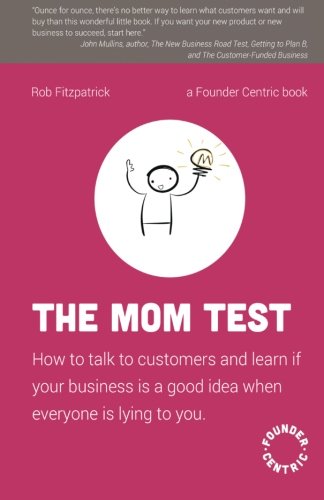
How product managers should talk to customers
Talking to customers and getting accurate information is hard … not because they lie but because they often tell you what they think you want to hear. This is never truer than with your own mother. The Mom Test helps ensure you improve your customer conversations.
Learning from the Lean Startup community
I had the privilege of attending the first ever Leanconf back in 2013, as well as the subsequent events in 2015 and 2016. This event was the first Lean Startup conference in the world and took place in Manchester in the UK. It was full of practitioners, entrepreneurs, intrapreneurs and a few wantrapreneurs from all over the world.
For those of you who haven’t come across the term intrapreneur before it means someone who drives new innovation within a company – with an entrepreneurial spirit.
At these events, I was lucky enough to have the opportunity to meet many thought leaders like Tristan Kromer, Ash Maurya, and Rob Fitzpatrick. If you haven’t already read our recent repost of Tristan Kromer’s post that defends the HiPPO I recommend checking it out. Anyone who has attended our flagship training course will know that we love the Lean Canvas as created by Ash Maurya.
Discovering the Mom Test
You might ask why set the scene like this? Well, one of the most valuable giveaways I have ever received was a copy of a little book called “The Mom Test”. Every attendee at the 2013 Leanconf got a free hard copy of this book that was just about to be published. The book was written by Rob Fitzpatrick and born from hard lessons learned from talking to customers. Even now, 5 years later, I recommend reading it to anyone who needs to talk to customers and understand their needs. The book is full of wisdom and founded on a very simple premise: if you ask your mother if your idea is good she will say “yes” because she loves you, is nice and wants you to feel good about yourself. I’m sure there are some mothers where this is not the case, but I think it stands true for most.

This carries over into discussions with customers who are likely to give you a more positive answer if you tell them about your idea, because your ego is on the line and they are fundamentally nice people, so they want you to feel good about yourself.
This then combines with other factors like confirmation bias and all a sudden what should have been a clear “no”, travels through “maybe” to “yes” at lightning speed.
And then when you start selling the product no one buys it and you wonder why? Especially because you had such positive feedback that confirmed the idea was great before you built the product!
What is the Mom Test?
The Mom Test aims to overcome this and sets out in 3 key points:
1. Talk about their world instead of your idea
2. Ask about specifics in the past instead of opinions about the future
3. Talk less and listen more
Advice to Product People
This is founded in the startup world but is still completely applicable to the corporate world as well. For product people I simplify it to “ask for stories, don’t pitch your product”.
Stories are very powerful as they reveal what happened in the past, the behaviors and problems that have occurred. They help you understand what problems people have had and how they tried to solve them. With the increasing ease of delivering products in the software world, the hardest thing generally is choosing what products to bring to market, and the key to that is understanding what problems are worth solving. If someone has already put effort into solving a problem, then that is a pretty good indication that there is value in solving it.
Better Customer Conversations
Having customer conversations that focus on stories, also clearly put you in the problem space, not the solution space. We are all guilty of crossing that line from time to time, but it is much easier to stay on the right side if you follow the Mom Test.
The book also covers a wide range of techniques to help get to the heart of things such as deflecting compliments and anchoring fluff – along with the warning signs that you are going wrong.
It sets out a process to talk to customers. Yes, you heard me right a process! Customers are your most valuable resource, and the insights they can give you are invaluable, so why would you not put structure around how you work with them?
The great news is that the Mom Test is also a really quick read at 134 A5 pages, fast readers can probably get through it on a flight to Europe or a train to London.
Phil Hornby
Independent Consultant


Leave a comment